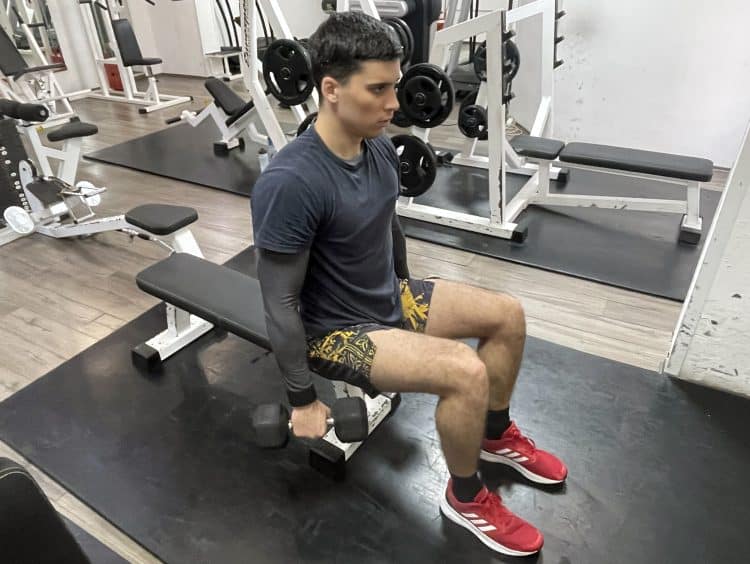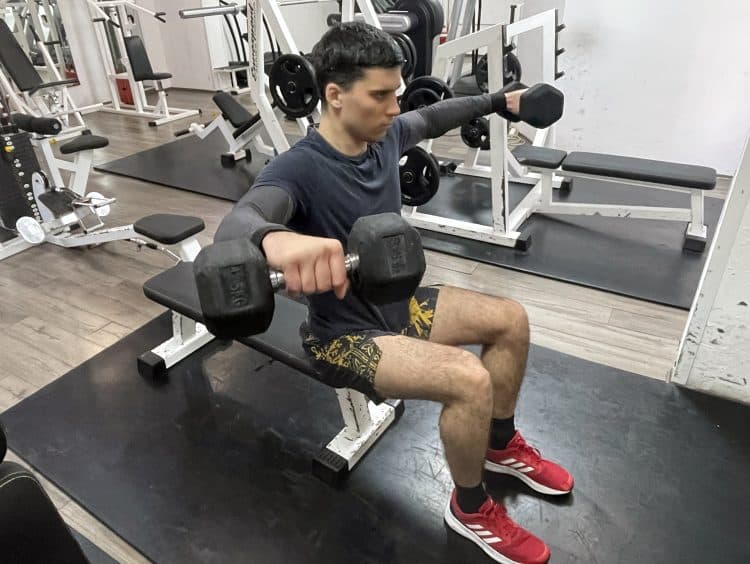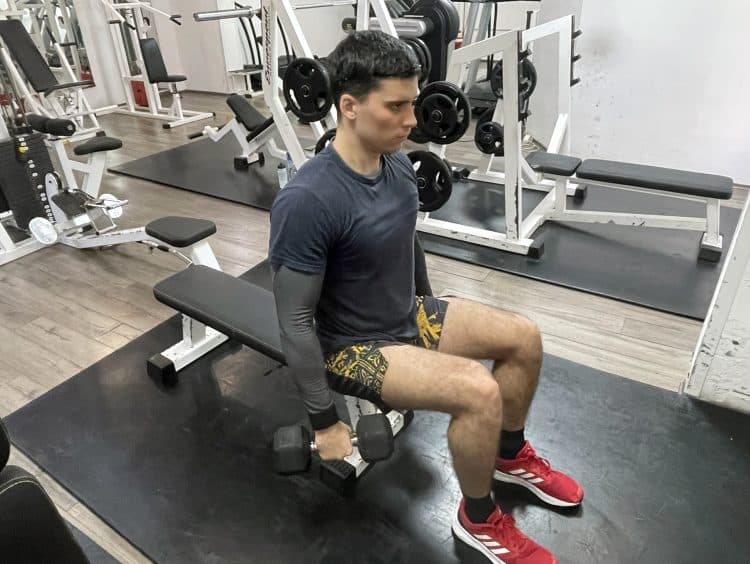In my experience, the seated dumbbell lateral raise is one of the best isolation exercises for promoting lateral deltoid hypertrophy. However, upon thorough research, I also found that strong shoulders are not only key for impressive aesthetics but are crucial for long-term shoulder health and joint stability.
In fact, a study concluded that the participants who developed shoulder pain had decreased muscle strength, particularly in the shoulder adductors, prior to the onset of shoulder pain. (1)
In the sections below, I will detail how to perform a seated dumbbell lateral raise properly, its benefits, drawbacks, and the best variations and alternatives to add to your workout routine.
How To Do a Seated Dumbbell Lateral Raise
Here is how to perform a seated dumbbell lateral raise properly.
Step One — Assume the Seated Starting Position
Pick two dumbbells of appropriate weight and sit on the edge of a flat bench. Bend your knees at 90 degrees and place your feet flat on the floor for optimal stability.
Level Up Your Fitness: Join our 💪 strong community in Fitness Volt Newsletter. Get daily inspiration, expert-backed workouts, nutrition tips, the latest in strength sports, and the support you need to reach your goals. Subscribe for free!
Maintain a straight back and keep your gaze forward. Hold the dumbbells at your sides with your elbows slightly bent.
Pro Tip: To avoid extreme discomfort and pressure on your elbows, don’t extend them fully at the beginning of each rep. I recommend my clients keep their elbows bent slightly during the movement to avoid straightening their elbows.
Step Two — Lift the Dumbbells
Lift the dumbbells out to the sides until your arms are at 90 degrees with your torso. Avoid lifting the dumbbells above 90 degrees since that will bias the traps. Hold the top position for one second before returning to the start position.
Pro Tip: When I am super tired, I contract my core as hard as possible to stabilize the trunk during the seated dumbbell lateral raise. This helps isolate the lateral delts.
Step Three — Return to the Starting Position
Slowly lower the dumbbells to the starting position with utmost control. This will help you develop better mind-muscle connection, increase the time under tension, and promote hypertrophy.
Pro Tip: Don’t let the dumbbells touch your body or the bench, as it can remove the tension from the target muscles. Just before the dumbbells touch anything, reverse the movement and begin the next rep.
Muscles Worked — Seated Dumbbell Lateral Raise
The lateral deltoids are the primary muscles working during seated dumbbell lateral raises.
Also, the secondary muscles include:
- Trapezius
- Supraspinatus
- Serratus anterior
- Forearms
- Core
Benefits of Seated Dumbbell Lateral Raise
Here are the advantages of performing seated dumbbell lateral raises:
Targeted Shoulder Strengthening
Seated dumbbell lateral raises are incredibly effective at strengthening your shoulder muscles complex. More precisely, this exercise is perfect for isolating the lateral deltoid head. Strengthening your shoulders and rotator cuff muscles is crucial for avoiding shoulder pain. (2)
Improved Shoulder Stability
Seated dumbbell lateral raises are perfect for improving your overall shoulder stability. Strengthening your lateral deltoid head will help stabilize your shoulder joint, which is crucial for avoiding gym injuries like shoulder and pec strains.
However, I suggest implementing additional exercises specifically targeting your anterior and posterior deltoid heads to protect your shoulders and stabilize them fully. This will result in strong deltoid muscles that will hold the shoulder joint in place from all sides.
Reduced Momentum Usage
Opting for a seated position during lateral raises is perfect for minimizing unnecessary movements often observed in the standing version of this exercise. However, there is still room left for cheating as you can move your torso back and forth.
However, doing so shifts the focus from lateral to posterior deltoid heads. To avoid this, contract your core to hold your trunk in place and avoid excessive forward bend.
Enhanced Posture
Shoulders play a big part in an overall healthy posture. Exercising regularly and implementing shoulder exercises such as seated dumbbell lateral raises will definitely help. Seated dumbbell lateral raises will strengthen your lateral deltoid head and upper back muscles, such as traps and rhomboids, which are crucial for healthy posture.
Better Muscle Isolation
Seated dumbbell lateral raises are much better for isolating your lateral deltoid head than the standing variation. Why? Because there is less space for cheating. However, if you use the textbook form, you have nothing to worry about.
Drawbacks — Seated Dumbbell Lateral Raise
Here are some of the drawbacks of this exercise:
Limited Range of Motion
The seated dumbbell lateral raise offers a limited range of motion compared to the standing variation because you can’t bring the dumbbells in front and toward the middle of your body.
Although this isn’t a big deal, I personally prefer to let the dumbbell move closer to the midline to get that additional deltoid stretch at the end range of motion.
Shoulder and Elbow Stress
You cannot eliminate shoulder and elbow stress during this exercise. However, there are two ways to reduce that stress. The first is obvious: use a machine like the lateral raise machine.
The second involves bending your elbows more during the concentric phase. This will shorten the “lever,” therefore reducing the stress on your elbows during the movement.
Level Up Your Fitness: Join our 💪 strong community in Fitness Volt Newsletter. Get daily inspiration, expert-backed workouts, nutrition tips, the latest in strength sports, and the support you need to reach your goals. Subscribe for free!
Reduced Core Engagement
Seated variation provides sufficient stability for your trunk, limiting core engagement. However, this is also why you must contract your core consciously during each repetition.
This way, you will exercise your core and provide additional stability and the ability to isolate your lateral deltoid muscles better with each rep.
Limited Functional Benefit
Seated exercises are less functional than their standing counterparts. That’s why seated dumbbell lateral raises should be integrated as accessory or supplementary exercises alongside staple movements like military presses, dumbbell overhead presses, and incline bench presses.
Variations and Alternatives — Seated Dumbbell Lateral Raise
Here are some of the best seated dumbbell lateral raise variations and alternatives you should consider:
Standing Dumbbell Lateral Raise
Standing dumbbell lateral raises are more functional than seated ones because they activate your trunk muscles to a greater degree.
Steps:
- Pick two dumbbells of appropriate weight.
- Place your feet hip-width apart or a little wider, depending on your personal preferences.
- Ensure your knees are slightly flexed, hips are neutral, and back straight.
- Raise both dumbbells away from your body to the sides.
- Hold the top position for one second and return to the starting position.
- Repeat for the desired number of reps.
Pro Tip: Squeeze your glutes and abdominal muscles right at the beginning of the exercise to achieve better stability throughout the movement. I find it quite useful to think about core stability and contracting abdominal muscles throughout the exercise to maintain proper balance and posture. This also helps me isolate the lateral deltoids more.
Cable Lateral Raise
Cable lateral raise is a unilateral shoulder exercise that will allow you to keep constant tension in your shoulder muscles throughout the entire movement.
Steps:
- Attach a D-handle cable in the low pulley position.
- Hold the cable machine pole with your right hand while taking the attachment in your left hand.
- Assume a hip-width stance, bend your knees slightly, keep your hips neutral, and look straight ahead.
- Slowly lift your left hand away from your body to the side and hold the top position for one second.
- Return the cable to the starting position and repeat.
Pro Tip: Try leaning slightly away from the cable machine while keeping your torso straight. This adjustment helps me increase the range of motion and intensified the focus on my deltoids.
Kettlebell Lateral Raise
Kettlebell lateral raises are similar to the dumbbell variation. However, they tend to be a little harder because of the equipment design.
Steps:
- Pick two kettlebells of appropriate weight.
- Lift both kettlebells away from your body to the sides and hold the top position for one second.
- Lower the kettlebells to the starting position and repeat for the desired reps.
Pro Tip: Focus on maintaining a controlled, slower tempo, especially during the descent. This increases time under tension, enhancing muscle activation and growth.
Barbell Overhead Press
The barbell overhead press is one of my personal favorite compound exercises for building foundational upper body strength.
Steps:
- Place the barbell on the squat rack at about shoulder height and load it with an appropriate weight.
- Grab the barbell with an overhand grip around the width of your shoulders.
- Unrack the barbell, step back, assume a shoulder-width stance, and keep your spine neutral.
- Push the barbell over your head until your elbows are fully extended.
- From the top position, slowly lower the barbell to the starting position and repeat for the desired reps.
Pro Tip: Squeeze your glutes and abdominal muscles for better stability and incorporate sharp abdominal exhales during the concentric phase of the lift. I noticed a significant improvement in ease and performance among my clients in executing this exercise after incorporating these three key cues.
Seated Dumbbell Overhead Press
The seated dumbbell overhead press is a semi-functional exercise because it requires stabilization due to the use of free weights. However, the seated nature of the exercise makes it a little less functional than the standing variation.
Steps:
- Pick two dumbbells and sit on the edge of a bench. You can also set an incline bench to 90 degrees if you prefer additional support and stability for your back.
- Raise the dumbbells over your head and ensure your elbows are fully extended.
- Slowly lower the dumbbells to the floor until the dumbbells are at your ear level.
- Hold the bottom position for one second and reverse the motion to return to the starting position.
Pro Tip: Engage your core and slightly arch your lower back while performing the seated dumbbell overhead press. In my experience, this posture stabilizes your spine and allows for a fuller range of motion, maximizing deltoid engagement.
FAQs
Are seated dumbbell lateral raises good?
Seated dumbbell lateral raises are good for lateral deltoid development, which is crucial for overall shoulder health, stability, and healthy posture.
Are lateral raises worth it?
Lateral raises are worth it because they improve lateral delt isolation and your shoulder health and posture. I advise performing them as supplementary or accessory exercises right after big compound lifts such as military presses and incline bench presses.
Why are seated lateral raises so hard?
You may experience difficulties performing seated lateral raises because of weak lateral delts. Many gym goers perform lateral raises in the standing position, as it allows them to cheat more by swinging their torsos.
When they transition to the seated variation, they experience difficulties because the compensatory movements they did before prevented their deltoid heads from developing sufficiently.
Do lateral raises build mass?
Lateral raises can definitely build decent shoulder mass. However, you also must do compound movements such as bench presses and overhead presses to achieve the best shoulder muscle hypertrophy.
Can I do lateral raises every day?
You shouldn’t do lateral raises every day as it can lead to overtraining, which can hamper your growth. Instead, most bodybuilders should perform around two quality shoulder sessions a week where they implement lateral raises. This negates overtraining and allows for sufficient recovery between workouts.
Wrapping Up
Seated dumbbell lateral raises are excellent for isolating the lateral deltoid head and building stronger, healthier, and broader shoulders.
I advise performing lateral raises towards the end of a push/shoulder workout as a finisher or superset to achieve better muscle hypertrophy. In the comments below, let me know how you implement seated dumbbell lateral raises in your workouts.
References:
- Mulroy SJ, Hatchett P, Eberly VJ, Haubert LL, Conners S, Requejo PS. Shoulder Strength and Physical Activity Predictors of Shoulder Pain in People With Paraplegia From Spinal Injury: Prospective Cohort Study. Phys Ther. 2015;95(7):1027-1038. doi:10.2522/ptj.20130606
- Hodgetts CJ, Leboeuf-Yde C, Beynon A, Walker BF. Shoulder pain prevalence by age and within occupational groups: a systematic review [published correction appears in Arch Physiother. 2022 Jan 10;12(1):3]. Arch Physiother. 2021;11(1):24. Published 2021 Nov 4. doi:10.1186/s40945-021-00119-w
Relevant Articles:
Interested in measuring your progress? Check out our strength standards for Bench Press, Cable Lateral Raise, Military Press, and more.











